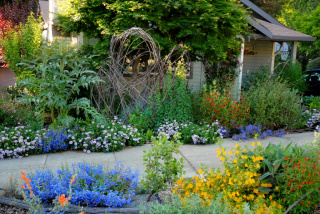Showcase Feature
Inspired by the Bringing Back the Natives Garden Tour, Joan and Jenn decided to convert their conventional lawn and shrubs to a sustainable, native and edible, drought tolerant landscape. Liz Simpson of Liz Simpson Garden Design guided the transformation of their “Bermuda grass wasteland” into an exuberant confection of colorful native plants and an abundance of edibles. Bright penstemon and monkeyflowers coexist with a changing kaleidoscope of seasonal veggies, such as asparagus, leeks, and kale, under the rustling branches of apple, fig, lemon, and plum trees. Dramatic rock walled raised beds delight passers-by and provide easier gardening access; hardware cloth deters moles.
Other Garden Attractions
• In the back yard lies a secret garden, where tranquil woodland natives encircle a figure eight meditation labyrinth and a tai chi spot, which overlooks Whittle Creek. Ferns, wild ginger, bleeding heart, and coral bells embrace a shrine created from the remnants of a venerable redwood.
Gardening for Wildlife
The bird feeders, nectar plants, and creek that flows year-round attract phoebes, chickadees, titmice, and hummingbirds. Salamanders and newts live in the damp places under fallen logs.Garden Talks
11:00 and 2:00 “Sheet mulching—free and easy; how to do a low-cost conversion from grass and weeds to natives and edibles” by Joan Lohman
How We Transformed Our Garden: Project OLE (Operation Layered Earth
Photos
Click to see as a slideshow:




















